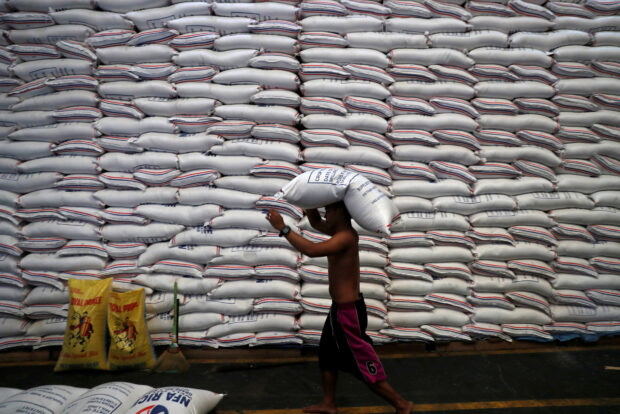Compliance with rice price ceiling still low

A worker carries on his head a sack of rice inside a government rice warehouse National Food Authority in Quezon City, Metro Manila in Philippines, Aug. 9, 2018. (File photo by ERIK DE CASTRO / Reuters)
MANILA, Philippines — Retail prices of rice in Metro Manila started to decline on Tuesday, the first day the price ceiling on the Filipino staple food took effect, according to a monitoring conducted by the Department of Agriculture (DA).
Locally produced regular-milled rice was selling from P41 to P52 a kilogram, while local well-milled rice was being sold from P45 to P53. Imported regular-milled rice was priced at P43 a kilogram, while imported well-milled rice retailed at the mandated ceiling of P45.
On Sept. 4, a day before the price cap took effect, local regular-milled rice retailed from P52 to P55 a kilogram, while local well-milled rice was sold from P48 to P56.
During the inspection and price monitoring operation of officials from the national and local governments at Mega Q Mart in Quezon City, Interior Secretary Benhur Abalos noted that a number of retailers were not yet complying with Executive Order No. 39, which President Ferdinand Marcos Jr. issued last week setting a ceiling of P41 a kilogram for regular-milled rice and P45 for the well-milled variety.
Several retailers were also noticeably closed during the inspection, with one small rice merchant saying some of them were contemplating closing their shops until the prices of rice have normalized.
Article continues after this advertisementAbalos said he had directed market masters or market administrators of local government units (LGUs) nationwide to effectively implement the price ceiling on rice.
Article continues after this advertisementHe also ordered the Philippine National Police to extend assistance to the DA, the Department of Trade and Industry (DTI), and LGUs in the enforcement of EO 39 and in the performance of their regulatory and executive powers.
“But today, we did not arrest or penalize anyone. We’re only reprimanding them, telling them that they should follow the price ceiling,” Abalos told reporters.
“For now, we are just doing an information drive [about EO 39]. But we are asking everyone to cooperate with the government. This is not permanent, only temporary,” he added.
Abalos said authorities would focus on going after the cartels, hoarders, and market price manipulators.
According to Abalos, he has directed LGUs “to try their best” to cushion the effects of the price cap on rice by giving rice retailers discounts or waiver of their monthly rent.
Local governments, especially in Metro Manila, also offered to provide assistance to retailers on top of the P15,000 subsidy from the national government.
Quezon City Mayor Joy Belmonte on Tuesday said she was not keen on penalizing rice retailers who would not be able to follow the price ceiling.
Belmonte said she was looking at a range of measures to help them cope with possible losses.
These include financial aid from the city government to retailers on top of the subsidy already promised by the national government, and possibly the waiving of rental fees for rice stores in public markets.
Noncompliance
Outside Metro Manila, retailers were selling rice above the price cap.
In Isabela province, limited supplies of regular-milled rice were sold at P44 a kilogram.
“It is a basic rule for us. We would rather close shop than be bankrupt,” said rice vendor Lorgita Birung.
“If we bring down the price to meet the price ceiling, we will be losing money,” said retailer Myla Juan, citing high delivery and handling costs.
Some rice retailers warned that they might close shop if the government continued to dictate the price of rice.
Most rice traders and retailers in Cebu, Bohol, Negros Occidental, and Leyte also defied the price ceiling.
Some sellers in Tacloban City even pulled out their regular- and well-milled rice from their shelves and instead sold the premium and special rice, which are not covered under EO 39.
Personnel from the DTI conducted their monitoring at Tacloban’s main public market and found out that only four out of more than 30 rice traders and sellers followed the price cap.
Frederic Dy, president of the Grains Retailers Confederation of the Philippines (Grecon) for Eastern Visayas, confirmed that many of their members were not following the order and just sold premium or special rice instead.
In Cebu, retailers were finding it hard to comply with EO 39, said Erwin Gok-ong, Grecon vice president in Cebu City.
Gok-ong said that if the government would impose a price cap of P41 a kilo, the rice should have been bought from their source at P38 a kilo to allow them to have a P3 profit per kilogram.
At present, he added, their cheapest rice was bought at P48 a kilogram.
Rice retailers in the province of Cotabato, a major granary of the staple food in Mindanao, also defied EO 39.
Carmelito Bacus, Grecon president in the province, said that instead of following the order, they would negotiate with the Local Price Monitoring Team to give them another week to dispose of their rice stocks that were bought at higher farm-gate prices to avoid incurring losses.
Bacus said that retailers in Cotabato agreed not to sell their regular- and well-milled rice based on EO 39 as they stand to lose P400 per 50-kilogram sack.